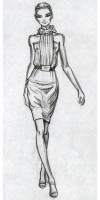Not so long ago, I started my retail/merchandising career in the juniors division at the corporate office of a retailer. It was so exciting to be in a place where I could wear the clothes that I worked with, and I was sure that picking out cute clothes all day was what I was meant to do! 
Then about a year later, I moved to the "missy" sportswear division, which I thought would be great, too, because cute clothes are easy to pick out in any area, right? Well - I thought wrong. You see, this company was based in Florida, where the missy area for retailers is long on conservative and short on trendy.
My first red flag was raised during my first “Hit or Miss” meeting, where the merchants display their top-selling items (hits) and their slow movers (misses). As you might have guessed, the very first hit was very far from a hit in my book. I just could not imagine 3,200 or so ladies actually choosing to wear a bedazzled hot pink shirt with flamingoes and seagulls swallowing up the fabric!
 Sadly, one of the "miss" items was a very cute peasant top that I could see wearing myself. Suddenly I got a sickening metallic taste in my mouth as I realized how bad a fit I was for missy sportswear in Florida.
Sadly, one of the "miss" items was a very cute peasant top that I could see wearing myself. Suddenly I got a sickening metallic taste in my mouth as I realized how bad a fit I was for missy sportswear in Florida.
Merchandising is not as easy as one initially thinks because it involves selecting merchandise for different arrays of individuals who may not all have the same taste as you. So how do we go about figuring out what to buy? This is an age old question…
There’s competitive shopping, but relying on that always puts you behind the trend. The largest tactic for conquering this question has been analyzing what sold in the past. Many merchants try to bring items back in the next season that had mediocre performance the previous season but only to then find that they are this seasons dogs.
The customer is constantly changing and evolving. Do you buy items that you already have? No, of course not. So then how do you determine what the customer will want? That is the magical question to merchandising.
Unless you've been living under a rock, I’m sure you’ve heard the term “Big Data”. Through all of the customer transactions in store and online, there becomes a wealth of data regarding sales. Then you also have the wealth of information on social media. I think we all are still dying to know what color that dress was on Facebook. For those who might not remember, a photo portraying a dress in two different colors went viral on social media. But what if you could instead ask the audience which color they would prefer? You’d know what color of the dress to buy before you buy it! Jackpot!
Answering the magical question to merchandising is now possible through analytics. We are able to understand which attributes such as colors, patterns, fabric, or silhouettes drove your business. But most importantly, we are able to predict which combinations of these attributes will drive your business in the future, including combinations that you didn’t even have in your assortment last season! We are able to integrate social media data as well.
We are able to do this through the use of predictive analytics. Utilizing predictive analytics gives merchants the ability to predict the evolution of the trends. This truly takes the guess work out of buying! If I had these analytical insights at the start of my career, I would have been able to leverage the insights and know that rhinestones and hot pink were the next evolution of the trend!
If you want to understand how analytics can help your business and why SAS can help you, check out the 2015 Forrester Wave for Predictive Analytics where SAS is named a leader. For a broader sense of our industry-specific expertise, I encourage you to visit our Retail Industry Solutions page. Let me know what you think!

